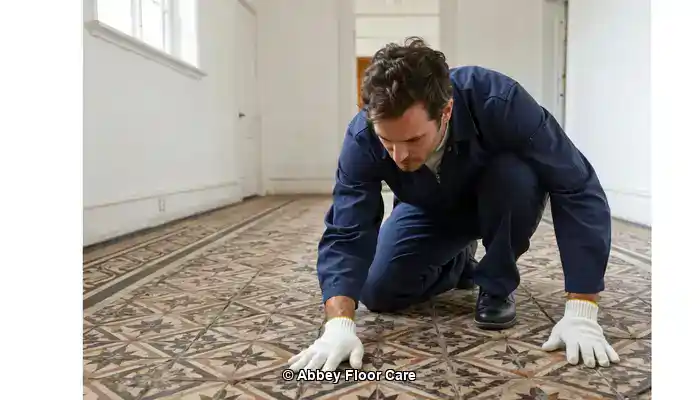
Last Updated on October 30, 2025 by David
Master the Art of Reviving Faded Victorian Mosaic Tiles with Proven Techniques
- Victorian mosaic tiles frequently experience colour loss due to a combination of ingrained dirt, outdated coatings, and general surface wear, affecting their visual impact significantly. The intricate designs and original hues fade, diminishing their visual appeal in any setting, and it’s crucial to understand these factors to restore the tiles effectively.
- Harsh chemicals and aggressive scrubbing can inadvertently strip away original pigments, particularly on encaustic and geometric tiles, leading to irreversible damage that compromises their beauty and historical significance. Understanding the risks of using abrasive materials is essential for anyone looking to maintain their tiles.
- Safe restoration starts with a thorough cleaning process that utilizes pH-neutral solutions alongside low-speed rotary machines equipped with soft brushes. This method preserves tile integrity while enhancing aesthetic appeal, ensuring that the restored tiles maintain their charm for years to come.
- Old sealers and waxes must be meticulously removed to uncover the genuine condition of the tile surface beneath. This essential step for effective restoration ensures that the tiles regain their original charm and allows for proper treatment of the underlying materials.
- Colour enhancement is attainable through the application of breathable, stone-safe sealers that intensify tone without forming an undesirable glossy film. This process preserves the natural look and feel of the tiles while ensuring they remain vibrant and true to their historical roots.
- Professional restoration can effectively revive original pigments without resorting to repainting or artificial colouring methods. This approach maintains the authenticity and historical significance that makes these tiles unique, ensuring they continue to be a cherished part of the architectural landscape.
- Proper maintenance of restored tiles involves implementing gentle cleaning routines and avoiding acidic or bleach-based products that could harm the surface and compromise the effectiveness of the restoration. Regular upkeep is key to preserving the beauty of your investment.
- Heritage-sensitive methods are crucial in safeguarding both the aesthetic appeal and historical significance of the tiles, ensuring that they remain valuable components of architectural heritage for generations to come. It is vital to adopt practices that respect the original craftsmanship while providing effective restoration solutions.
Understanding the Significance of Restoring Victorian Mosaic Tiles for Heritage Preservation
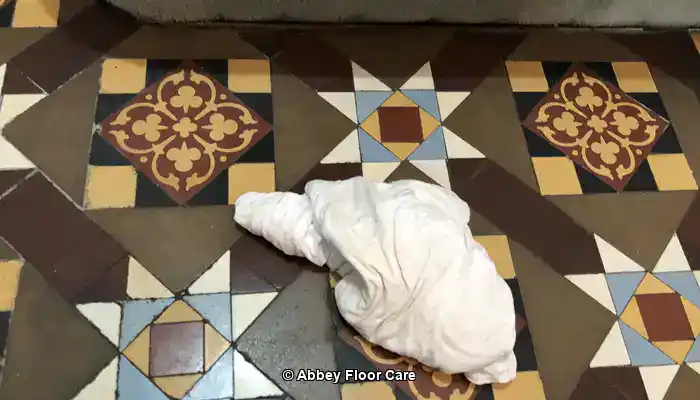
Victorian encaustic and mosaic tiles are an essential element of British architectural heritage, renowned for their intricate craftsmanship and distinctive colour palettes derived from mineral pigments that are fused directly into the clay tile bodies. This unique construction creates a vibrant aesthetic that endures through time and usage, making their restoration vital for preserving cultural significance.
Pro Tip: Essential Products for Effective Daily Maintenance of Victorian Tiles

Fila Pro Floor Cleaner
|
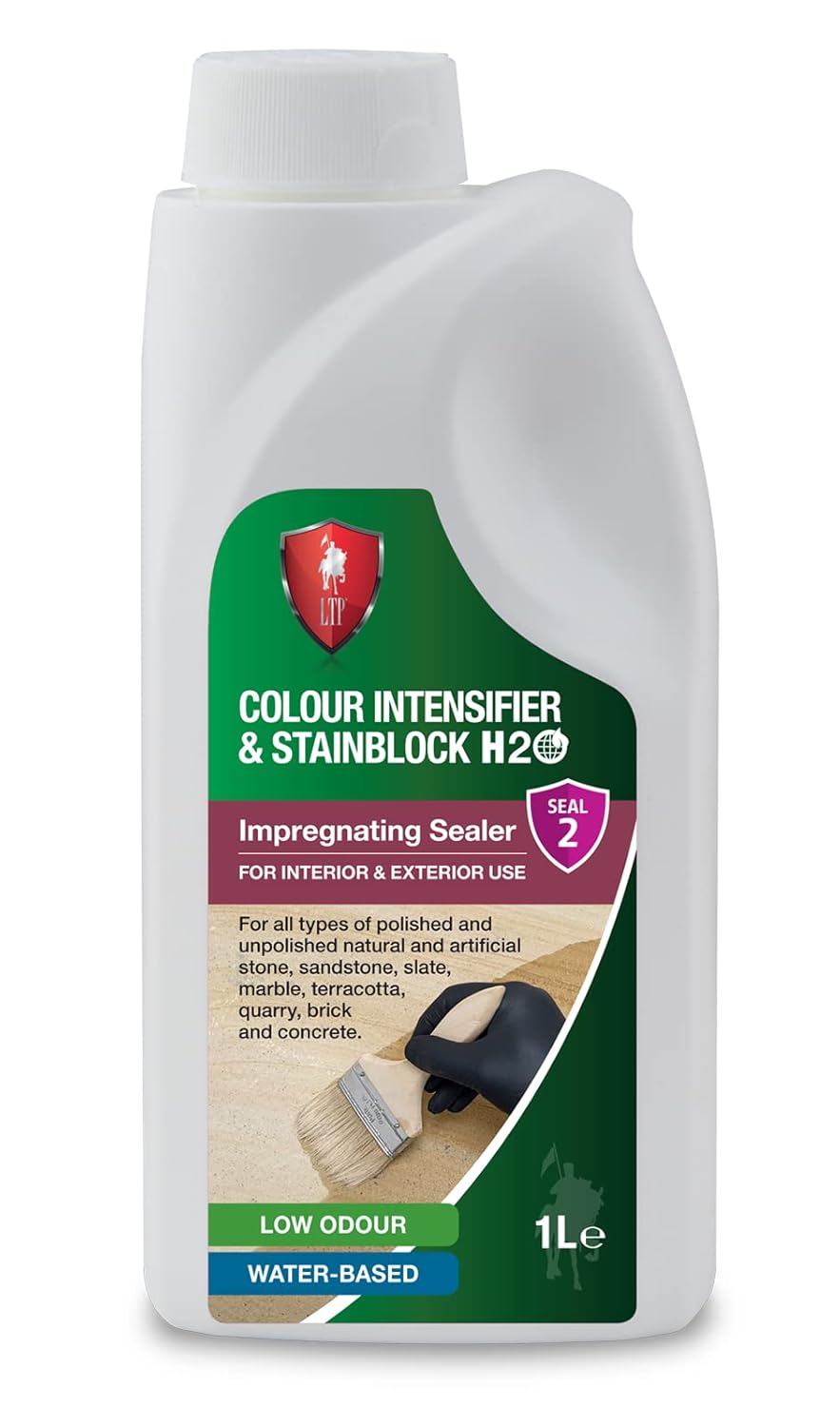
LTP Colour Intensifier & Stainblock H20
|
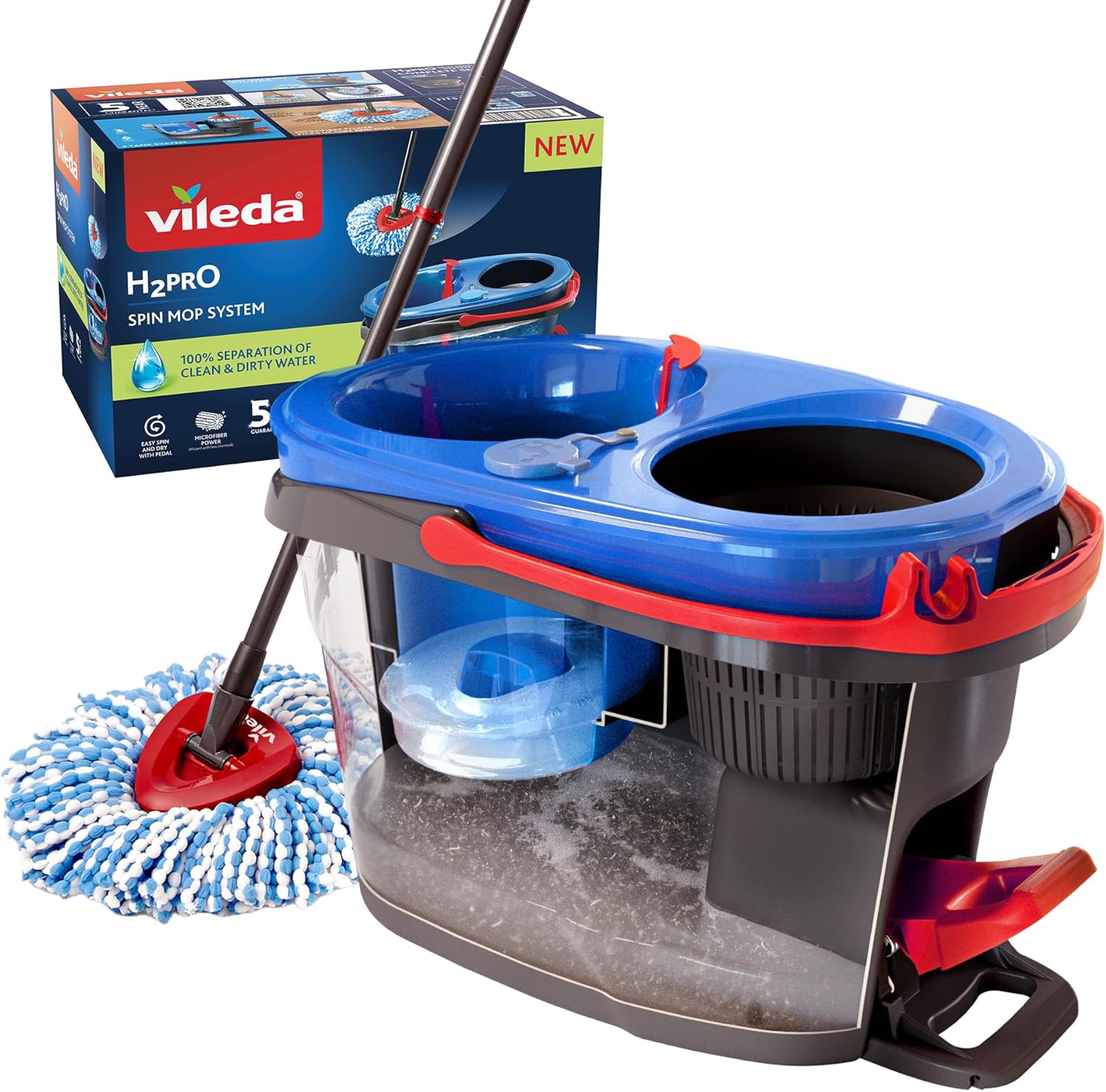
Vileda H2PrO Spin Mop System
|
However, over time, these tiles often lose their visual impact due to surface wear, chemical effects, and environmental influences. The process of restoring their original vibrancy is a specialist task that necessitates an in-depth understanding of the materials used, historically accurate techniques, and high-quality products tailored to preserve their integrity, ensuring they continue to be a striking feature in any space.
Identifying Key Factors Leading to Fading and Dulling of Victorian Mosaic Tiles
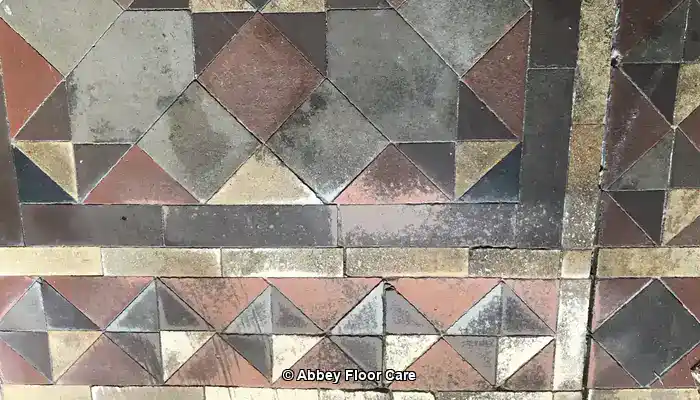
Example of Victorian Clay Tile Floor dulled through surface wear and damage.
Despite the pigments being integral to the tile, a multitude of factors contribute to fading and dulling over time, including:
- Accumulated dirt and grime: Continuous foot traffic deposits fine particles and oils that infiltrate porous surfaces, scattering light and muting vibrant colours, which diminishes their overall appeal and visual quality. Regular cleaning is essential to prevent this buildup from affecting the tiles’ integrity.
- Wax and polish buildup: Layers of wax or sealants that lack breathability can trap moisture, resulting in a cloudy or discoloured appearance on the tile surface. This buildup further impacts their presentation and aesthetic value, making timely removal crucial for effective restoration.
- Moisture-driven issues: Many Victorian tiles were installed over subfloors without damp-proof membranes, leading to rising damp that transports soluble salts. This crystallisation on the tile surface manifests as efflorescence, obscuring the original tones and complicating restoration efforts. Awareness of moisture issues is vital for successful restoration.
- Physical abrasion: Small surface scratches incurred over years of use disrupt smooth light reflection, diminishing the overall visual richness of the tiles and making them look worn and unattractive. Addressing these abrasions is key to restoring the tiles to their former glory.
Effective restoration must carefully address each of these contributing factors without compromising the tile’s historic integrity and structure. This approach ensures the restoration process is thorough and respectful of the original craftsmanship that defines these beautiful tiles.
Understanding the Importance of Breathability in Restoring Tiles Without a Damp-Proof Membrane
As many Victorian tiled floors are situated on older subfloors that lack a damp-proof membrane (DPM), it is essential that their natural clay structure remains permeable. This allows subfloor moisture to evaporate effectively, preserving the tiles’ condition and preventing long-term issues. Non-breathable wax coatings or film-forming sealers can obstruct this crucial evaporation pathway, leading to moisture accumulation beneath the surface. Such entrapment of salts and humidity can result in efflorescence, surface mineral degradation, and an unwelcome phenomenon known as wax blooming—a whitish haze that appears on the tile. Restoration plans must prioritize the use of breathable impregnating sealers that protect the tiles while allowing moisture vapor to migrate freely, thereby preventing long-term damage and deterioration of these historical features.
Diving into the Composition of Pigments and the Structure of Victorian Tiles
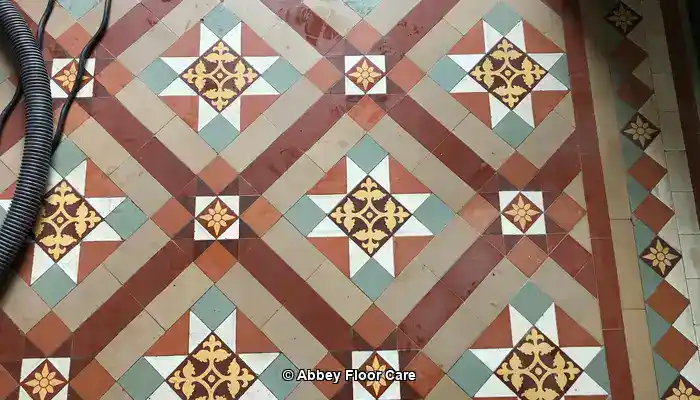
An example of different pigments in a Victorian Clay tile floor during restoration by Abbey Floor Care
Exploring the Mineral Oxide Pigments Used in Victorian Tiles
Victorian mosaic and encaustic tiles derive their characteristic earthy hues from mineral oxide pigments embedded directly into the clay. These pigments provide durability and contribute to the depth of colour, offering a rich visual experience that captivates and enchants. The primary pigments found in these tiles include:
- Iron oxide: generates shades of terracotta reds, rust browns, and soft ochres, adding warmth to the tiles and enhancing their overall appeal. This pigment is fundamental in creating the inviting tones typical of Victorian mosaics.
- Manganese: yields deep browns and rich blacks, enhancing the contrast and depth of the tile designs, making them visually striking. The use of manganese is critical for creating dramatic elements in tile patterns.
- Cobalt: imparts a range of blue hues, adding a cool contrast to the warmer tones and enriching the colour palette. This versatility makes cobalt a valuable pigment in tile design.
- Chromium: creates natural green shades, further diversifying the colour palette and contributing to the unique aesthetic of Victorian tiles. The introduction of chromium pigments adds to the complexity and beauty of these historical works.
Understanding the Firing Process That Fuses Pigments in Tile Production
During their manufacture, the tiles are subjected to firing at temperatures reaching approximately 1100°C. This process vitrifies the clay and fuses the pigments deeply into the tile body, ensuring that the colour permeates throughout the tile rather than merely residing on the surface. This method guarantees long-lasting vibrancy and colour stability, which is essential for preserving the aesthetic appeal of the tiles over time.
Characteristics of the Porous Unglazed Finish of Victorian Tiles
Victorian tiles typically showcase a porous, unglazed matte finish, which contributes to their natural aesthetic. However, this inherent porosity renders the tiles absorbent and susceptible to surface contamination and moisture, necessitating meticulous cleaning and maintenance to preserve their condition. Understanding these characteristics is fundamental to ensuring the longevity of the tiles and preventing future deterioration through informed care practices.
Evaluating Colour Durability Across Different Types of Tiles
Natural earth pigments, particularly in red and yellow tiles, often contain fewer mineral additives than darker colours like black, which are formulated with manganese. This disparity results in red and yellow tiles being less durable and more prone to surface dishing under heavy foot traffic. Such wear manifests as shallow depressions where footfall is concentrated, leading to uneven colour intensity and a noticeable loss of surface flatness, which can detract from their overall appeal and historical value.
Essential Considerations for Successful Restoration of Victorian Tiles
Understanding pigment composition and wear patterns is crucial when planning a restoration. Softer-toned tiles necessitate gentler cleaning methods and tailored impregnating sealers that respect their physical properties while enhancing colour. In contrast, darker, more resilient tiles can endure more intensive cleaning but still require breathable, colour-enhancing protection to maintain vibrancy over time. This balance ensures that the restoration remains effective and long-lasting while respecting the historical significance of the tiles.
Effective Cleaning Techniques to Revive the Beauty of Victorian Mosaic Tiles
Effective cleaning is paramount to reviving Victorian encaustic and mosaic tiles to their original vibrancy. However, the cleaning process for these tiles demands a specialized approach that transcends the use of simple pH-neutral detergents commonly recommended for everyday cleaning. Professional restorers utilize carefully formulated alkaline cleaners combined with mechanical techniques to break down heavy soiling and old residues without compromising the historic fabric of the tiles.
Systematic Strategies for Removing Debris from Tile Surfaces for Optimal Cleaning
The cleaning process initiates with the removal of all loose dirt and grit using soft brushes or vacuuming with brush attachments. This preliminary step is crucial in preventing scratches on the delicate tile surfaces during subsequent cleaning phases, thereby safeguarding their aesthetic quality and ensuring a thorough restoration that respects the original craftsmanship of these valuable tiles.
Utilizing Alkaline Cleaners for Intensive Soil Removal from Victorian Tiles
In contrast to pH-neutral cleaners, which often lack the chemical strength necessary to tackle ingrained fatty acids and organic soils, alkaline cleaners are essential for thoroughly breaking down household oils, grease, and sticky residues frequently found on tile surfaces and in grout lines. These alkaline formulations dissolve the binding agents of dirt, sugars, and fats, allowing for effective removal while ensuring compatibility with the mineral composition of Victorian tiles. Professional-grade alkaline products, such as PS87 PRO or bespoke formulations from heritage cleaning specialists, are typically employed in a diluted form. This ensures deep cleaning without being overly aggressive towards the clay body. It is vital to remember that even with alkaline cleaners, caution is necessary, and spot testing is always recommended to avoid potential damage to the tiles.
Employing Mechanical Agitation with Suitable Pads for Enhanced Cleaning Efficiency
Mechanical action significantly enhances cleaning efficacy. Low-speed rotary scrubbers fitted with red or, in some cases, green non-abrasive pads are commonly employed to agitate soils out of small pits, tile surfaces, and grout lines. These pads clean thoroughly while preserving the integrity of tile edges and delicate surface details, ensuring that the overall aesthetic remains intact and the restoration is successful while respecting the original design of the tiles.
Thoroughly Eliminating Waxes and Exotic Sealants for a Fresh Start in Restoration
Years of use often result in the accumulation of old waxes and sealants, particularly from DIY attempts utilizing unsuitable products. Water-based cleaners—either alkaline or mildly acidic—are preferred for eliminating these residues without compromising the tile’s mineral structure. Nevertheless, stubborn ‘exotic’ or solvent-resistant coatings necessitate the use of targeted solvent-based removers such as Lithofin Wax-Off or LTP Solvex. These solvents effectively soften and emulsify waxes and old sealants but must be handled carefully by professionals trained in their safe application and disposal, ensuring no further damage occurs during the restoration process.
The Critical Importance of Rinsing and Drying After Cleaning to Ensure Tile Integrity
Following the chemical cleaning process, thorough rinsing is critical to eliminate all cleaning residues. Multiple rinses with clean water, complemented by wet vacuum extraction, ensure that no traces of detergent or solvent remain to interfere with subsequent restoration coatings. The drying time can vary based on environmental conditions such as humidity, surface type, and moisture content. Restoration experts consistently utilize moisture meters to verify that the tiles are completely dry before applying any impregnating sealers or protective treatments. This meticulous approach prevents moisture entrapment, which could otherwise cause efflorescence, staining, or damage beneath sealed layers, thus maintaining the structural integrity of the tiles.
Comprehensive Cleaning: Key to Restoration Success and Aesthetic Quality
Thorough cleaning reveals the actual condition of the tiles by eliminating visual obstructions. It exposes areas that may require repair and provides a clean, receptive surface for colour-enhancing impregnators or other restorative products. This careful preparation is fundamental to the success and longevity of Victorian mosaic tile restoration, ensuring that the final results are not only aesthetically pleasing but also durable and reflective of the tiles’ historical significance.
Enhancing Colour with Premium Impregnating Sealers for Optimal Results in Tile Restoration
Restoration professionals employ impregnating colour-enhancing sealers produced by LTP and <a href=”https://amzn.to/4ntC8ma”>Lithofin, </a> brands esteemed for their advanced, heritage-approved formulations. Unlike superficial coatings, these sealers:
- Penetrate deeply into tile pores, physically enriching colour by altering light refraction, thereby enhancing visual appeal and depth in the tiles. This depth is crucial for maintaining the tiles’ vibrant appearance.
- Maintain vapour permeability, which is essential for moisture escape, particularly in older floors lacking DPM layers, to prevent future damage and deterioration. This feature is vital for preserving the integrity of historical tiles.
- Provide long-lasting protection against stains and foot traffic without modifying the natural texture or gloss of the tiles, ensuring they remain authentic and true to their historical origins. This balance is key to maintaining the tiles’ original beauty.
- Applied in multiple light coats, each allowed to penetrate before the next is applied, ensuring complete uniformity across the surface for a flawless finish that respects the original design. This careful application is critical for achieving the best results in restoration.
These sealers effectively combat fading by restoring vibrancy while preserving the historic floor’s breathable characteristics, making them an essential part of the restoration process that ensures longevity and beauty in Victorian tiles.
Implementing Effective Techniques for Repairing Damaged Tiles and Colour Tinting for Restoration
Tiles exhibiting chips, cracks, or missing pieces necessitate careful repair utilizing tinted epoxy or lime-based mortars, colour-matched with natural mineral oxides to ensure cohesion with the original design. Restoration experts often source matching replacement tiles from salvage archives to maintain pattern continuity and aesthetic integrity. Colour tinting involves the selective application of earth-pigment-infused wax or resin mixtures, which are sensitively applied to blend worn or missing pattern areas while respecting tile breathability and reversibility for future restorations, ensuring that any repairs are both effective and respectful of the original design.
Best Practices for Effective Tinting of Tiles to Ensure Seamless Integration
- Utilize small, controlled applications to avoid overt colouring of the tiles, ensuring a natural look that blends seamlessly with the original patterns. This precision is essential for maintaining the tiles’ authenticity.
- Conduct patch testing on inconspicuous areas before undertaking complete application to ascertain compatibility, preventing any unintended issues that may arise during the restoration process. This step is crucial for achieving a harmonious finish.
- Ensure that the tinting materials are compatible with the impregnating sealers applied to the entire surface to prevent adverse reactions and to maintain the integrity of the restoration, ensuring the final outcome is both beautiful and durable.
Maintaining Restored Victorian Mosaic Floors: Strategies for Longevity and Aesthetic Appeal
To preserve the restored colour and condition of Victorian mosaic tiles, ongoing care is essential. Regular maintenance ensures that these historic features remain vibrant and intact:
- Regular cleaning with pH-neutral, non-abrasive detergents specifically formulated for historic tiles to avoid damage and maintain their aesthetic quality. This routine is vital for preventing dirt accumulation.
- Implementing preventive measures such as placing entrance mats to minimize dirt ingress and protect the surface from wear and tear over time, thus prolonging the life of the tiles. This proactive approach is critical for long-term maintenance.
- Promptly addressing liquid spills, particularly acidic substances like vinegar or wine, to prevent surface etching and damage that could compromise the restoration and aesthetic integrity of the tiles. Timely intervention is key to preserving tile quality.
- Regularly reapplying breathable impregnating sealers every 3–5 years or as wear suggests to maintain protection and vibrancy, ensuring the tiles remain in excellent condition and continue to impress. This periodic maintenance is essential for long-term preservation.
- Continuously monitoring floors for signs of efflorescence or moisture ingress, which may indicate underlying damp issues requiring immediate attention to prevent further deterioration and preserve the integrity of the tiles. Vigilance is crucial for maintaining tile health.
Avoiding Common Mistakes in Restoration for Optimal Results
- Steer clear of wax treatments that can obstruct breathability, cause efflorescence, or lead to the phenomenon known as wax blooming, which detracts from the tile’s appearance and historical authenticity. Understanding the implications of wax use is critical.
- Avoid using acrylic or polyurethane sealants that can trap moisture and lead to tile degradation over time, compromising the restoration and the original craftsmanship. Choosing the right sealants is essential for long-term success.
- Limit the use of harsh chemical cleaners, as they can erode both the clay and the pigments embedded within the tiles, reducing their durability and overall appeal. Selecting appropriate cleaning methods is vital for preserving tile integrity.
- Never attempt to repaint tiles; paint films alter their visual and physical properties and are not reversible, risking further damage to the original tiles and their historical value. Respecting the original materials is essential for restoration.
- Recognize and address issues in older subfloors before sealing to prevent future problems that could affect the integrity of the restored tiles and their long-term aesthetic quality. Preemptive measures are key to successful restoration.
Spotlighting Successful Restoration Projects to Inspire Future Efforts
Real-life examples highlight the successful application of these principles in restoring Victorian mosaic tiles:
Reviving a Historic Victorian Hallway: A Restoration Project in Sheffield

Our careful cleaning process eliminated years of wax and grime, followed by the application of a Lantania Avo colour-enhancing impregnating sealer that visibly deepened the colours of the tiles. This was further complemented by applying an acrylic topical sealer to provide surface protection, particularly on floors installed over a damp-proof membrane, ensuring the tiles remain vibrant and protected for years to come.
A Civic Mosaic Floor Restoration in Chesterfield: A Testament to Expert Techniques
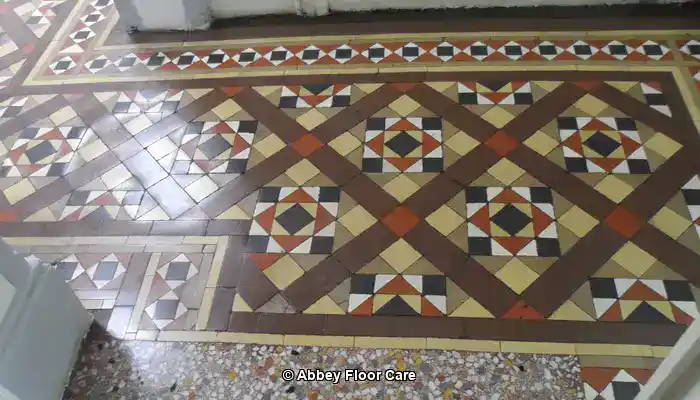
After meticulously cleaning and removing old topical sealers, the floor was sealed with an LTP Colour Enhancing Impregnating sealer. The surface was further protected with a wax, which was carefully applied to seamlessly integrate the clay tiles into the historic fabric of the building, preserving its unique character and ensuring the restoration remained true to its original design.
Protecting Architectural Heritage Through Expert Restoration Practices
The process of restoring the colour and pigment of Victorian mosaic tiles is a multifaceted challenge that balances material science, craftsmanship, and a deep respect for heritage values. By utilizing premium impregnating colour-enhancing sealers from industry leaders such as Dry Treat, Lantania, and Lithofin, professionals ensure long-term breathability, protection, and vibrancy of the colours. Skilled cleaning, meticulous repair, and dedicated maintenance are all crucial in preserving authenticity while rejuvenating these historic floors for future generations to appreciate and enjoy.
Frequently Asked Questions About Victorian Tile Restoration
What are Victorian mosaic tiles?
Victorian mosaic tiles are decorative tiles that gained popularity in the 19th century, renowned for their vibrant colours and intricate patterns. They were frequently utilized in both public buildings and private residences, showcasing the artistry and craftsmanship of their time.
How can I restore faded Victorian mosaic tiles effectively?
Restoring faded Victorian mosaic tiles involves a comprehensive process of cleaning, repairing any damages, applying new pigments to match the original colours, and subsequently sealing the tiles to protect them from future degradation, ensuring their beauty lasts for generations.
What materials are essential for tile restoration?
Key materials required for tile restoration include specialized cleaning solutions, pigments, adhesives, grout, and protective sealants, all selected for their compatibility with the original tiles to ensure a seamless restoration process that respects their historical significance.
How long does the tile restoration process typically take?
The duration of tile restoration varies widely based on the size and condition of the area being restored, typically ranging from a few days for smaller projects to several weeks for larger restorations, depending on the extent of the work required and the specifics of the restoration techniques applied.
Can I undertake the restoration myself?
Yes, smaller restoration projects can be managed as a DIY task if you possess the necessary skills and tools; however, more complex repairs necessitate professional expertise to ensure high-quality results that respect the tiles’ historical significance and integrity.
What is the expected cost of restoring Victorian mosaic tiles?
Cost estimates can fluctuate significantly based on the project’s size and condition, ranging from a few hundred to several thousands of pounds for comprehensive restorations, influenced by materials and labour involved, as well as the expertise required for effective restoration.
How do I select the right restoration expert?
When choosing restoration professionals, look for individuals with a proven track record in historical projects, positive reviews, and a commitment to using authentic materials and techniques that respect the original craftsmanship, ensuring quality work that preserves the essence of your Victorian tiles.
What challenges do restorers commonly encounter during the restoration process?
Restorers often face challenges such as matching original colours, repairing damaged tiles, and ensuring the longevity and durability of the restoration work to withstand time and use, making expertise essential in overcoming these hurdles.
How can I maintain my restored tiles effectively for long-lasting beauty?
Regular cleaning with pH-neutral products, avoiding harsh chemicals, periodically resealing, and promptly addressing any damage are key practices to maintain restored tiles in excellent condition, preserving their beauty and integrity for future enjoyment.
What innovations are currently influencing tile restoration practices?
Recent innovations in the field include advanced cleaning solutions, new types of sealants, and digital technology for precise colour matching and pattern replication in restoration projects, enhancing the effectiveness and efficiency of restoration efforts while ensuring high standards of quality.
The Article Restoring Colour and Pigment to Faded Victorian Mosaic Tiles first found on https://www.abbeyfloorcare.co.uk
The Article Restoring Victorian Mosaic Tiles: Reviving Colour and Pigment appeared first on https://fabritec.org
The Article Restoring Victorian Mosaic Tiles for Vibrant Color Revival Was Found On https://limitsofstrategy.com
The Article Restoring Victorian Mosaic Tiles for a Colourful Revival First Appeared ON
: https://ad4sc.com
Comments are closed